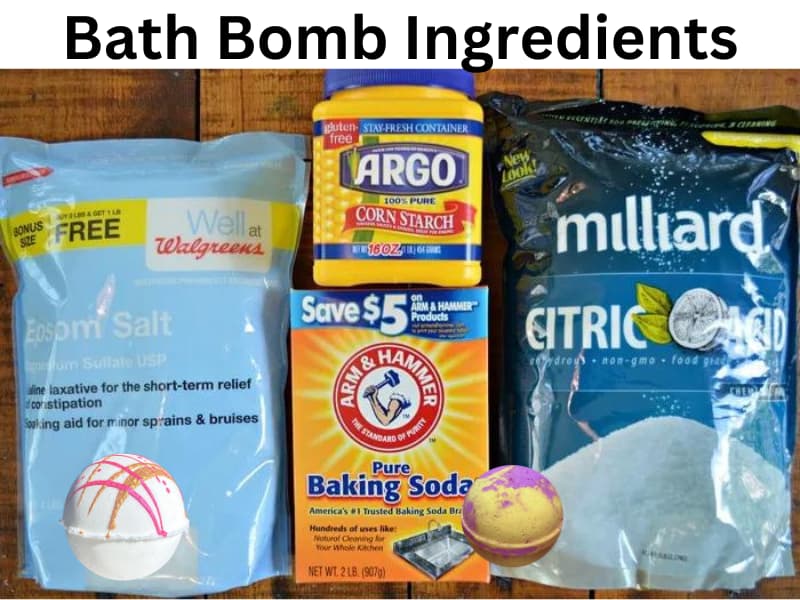Bath bombs have many ingredients, primarily baking soda, citric acid, and cornstarch. While the first two create the fizzing and bubbling effect of bath bombs, cornstarch ensures all the ingredients stick together to form the ball of bath bombs we all love.
You can add more ingredients to your bath bombs if you’re not allergic. This means there are so many types and varieties of bath bombs on the market that you can never get bored trying them out.
I’ve been making bath bombs since I discovered them in my local store after moving to Washington. In my experiments and trials, I’ve discovered that the quality of a bath bomb is in the quality and quantity of the ingredients. I discuss this below.

What are bath bombs made of?
Bath bombs are made of dry ingredients that effervesce and release fragrances and oils once they come into contact with water. Some of the primary ingredients for bath bombs are as follows:
1. Baking Soda (Sodium Bicarbonate)
Baking soda is the main ingredient in bath bombs, and it helps create a fizzing reaction when it comes into contact with water. It also soothes the skin.
2. Citric Acid
Citric acid is the other essential ingredient in baking bombs as it reacts with baking soda to produce the bubbling and fizzing typical of bath bombs. It’s a weak organic acid naturally found in citrus fruits.
3. Cornstarch or Arrowroot Powder
These added ingredients bind other ingredients together and create a smoother texture for the bath bomb. You can use either of them.
4. Epsom Salt (Magnesium Sulfate)
Epsom salt is an optional ingredient that helps relax muscles and relieve tension. It also benefits the skin.
5. Butter and Oils
You can also add oils and butter such as shea butter, cocoa butter, coconut oil, and others to moisturize the skin and make the water luxurious and silky.
6. Essential Oils
Essential oils, such as lavender and tea tree oil, are added to bath bombs to add scents and provide other benefits. Some help relax and treat the skin, while others rejuvenate the body.
7. Colorants
You can add color to your bath bombs either using cosmetic-grade or natural colorants such as turmeric, spirulina, and beetroot powder. I use turmeric since I prefer natural ingredients for my bath bombs.
8. Water or Witch Hazel
You need a liquid to bind the dry ingredients together. While most people use water, it can prematurely activate the ingredients. For this reason, I use and recommend witch hazel since it doesn’t activate the baking soda and citric acid but still helps get a good bath bomb out of the mold.
9. Optional Ingredients
You can also add glitter, herbs, dried flower petals, and other decorative ingredients as you deem fit.
To prevent clogs, I recommend using small or water-soluble ingredients. I use glitter since it has the least risk of clogging my drainage, unlike dried rose petals.
Bath bomb recipe for sensitive skin
If your skin is sensitive, you need to use gentle and hypoallergenic ingredients in your skin products, such as bath bombs, to avoid any irritations. I react to most commercial products with parabens and alcohol, but I have managed to create a gentle recipe for my bath bombs.
Some of the ingredients you will use to make a bath bomb include the following:
- 1 cup baking soda
- ½ cup cornstarch or arrowroot powder
- ½ cup citric acid
- ¼ cup Epsom salt (optional)
- 2 tablespoons of an unscented, mild oil like sweet almond or coconut oil
- 10-15 drops of a gentle essential oil such as rosemary, calendula, chamomile, lavender, or tea tree oil
- Natural colorant (optional)
- Witch hazel in a spray bottle
- Dried chamomile flowers or calendula petals (optional)
With these ingredients, follow these steps:
- Thoroughly mix baking soda, citric acid, cornstarch or arrowroot powder, and Epsom salt in a large bowl.
- In a smaller bowl, mix the essential oil with the unscented oil. I use tea tree essential oil since it’s mild, smells good, and has antiseptic properties.
- Slowly add the oil mixture to the dry ingredients while mixing them. You should obtain a mixture with the consistency of wet sand.
- Add small amounts of colorant to the mixture as you mix it up until you have a consistent color. Use as little colorant as possible since it can be potent.
- If you’re adding the dried flower petals, gently fold them into the mix at this stage.
- Lightly spritz the mixture with witch hazel (or water) until you get a mixture hard enough to retain its shape when squeezed by hand. Avoid overspraying since it’ll mess up the whole procedure.
- After that, put the mixture into bath bomb molds. If you don’t have the molds, use your hand or an ice cream scoop to compress them into the desired shapes.
- Allow them to dry in 24 hours. If that’s too long, place them in a freezer for 30 minutes, then remove them from the molds.
- Store your bath bombs in airtight containers for later use.
Always test the mixture of ingredients on a patch of the skin to determine if they are mild enough for your skin. I realized that tea tree oil can have a burning sensation if you use more than the recommended amount.
Always clean your tub after using a bath bomb to remove any remaining ingredients that may harm you. If you have a free standing tub, be careful not to knock it over when cleaning.
Are bath bombs safe for kids?
Your kid can enjoy bath bombs as well, but with the right precautions and under your watchful eye as follows:
1. Consider the Age
Bath bombs are safer for older children aged 3 years and above. Younger children may not understand the safety concept of not rubbing their eyes or ingesting the contents of the bath bombs hence posing a risk to themselves.
2. Always Supervise
You should always supervise your children when using bath bombs. Ensure they understand that bath bombs are for external use only, and not for ingestion.
3. Sensitivities and Allergies
Always keep a record of the allergies and sensitivities in your children. If you know that your child is allergic or sensitive to a certain ingredient in the bath bomb, don’t allow them to use it.
4. Use Safe Ingredients
Choose bath bombs that are labeled as safe for children. Besides that, go for organic ingredients instead of their chemical alternatives since the latter can be harsh even to adults.
Some ingredients, such as eucalyptus and menthol, can be good for you but may harm the child as they may cause chills owing to their cooling effect. Eucalyptus and menthol can also harm their eyes and respiratory distress.
5. Choose Smaller Bath Bombs
Smaller bath bombs have fewer ingredients than larger ones. They are thus better for children since they don’t overwhelm them with fizzing and too many chemicals on their delicate skins.
6. Keep a Safe Bath Water Temperature
While bath bombs fizz better with warm to hot water, you have to reduce the temperature of the water for your child.
Also, ensure the water doesn’t become cold while the child is still bathing.
7. Follow Instructions
If you’re not making your own bath bombs, read the manufacturer’s instructions to avoid harming your child. Just because you bought a lavender-scented bath bomb and lavender is safe for children doesn’t mean the bath bomb is safe for them.
8. Rinse Thoroughly After Use
Right after your child comes out of the bath, rinse them thoroughly to remove any remnants of the bath bombs. This prevents irritation that may come from the bath bomb ingredients.
9. Store Them Properly
Bath bombs smell good and look good too. To a child, that’s a sign of a sweet or something to be eaten or played with. You should keep them away from their reach for this reason.
Keeping your bath bombs safe also has the advantage of preserving their ingredients. If you keep them in airtight containers, they will remain fresh. This prevents the ingredients from getting spoiled and likely harming your child.
Conclusion
In summary, you only need 3 ingredients to make a bath bomb: baking soda, citric acid, and a binding agent like cornstarch or arrowroot powder. You can add as many other ingredients as possible to make the bath bomb of your choice.
Your children may love your bath bombs, but they need to be watched as they use them since they can ingest the bath bombs, rub their eyes with them, or get irritated from them. Luckily, you can make bath bombs with mild ingredients just for them.
